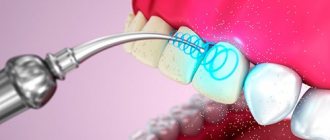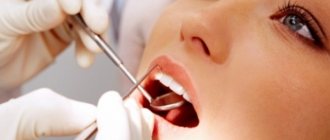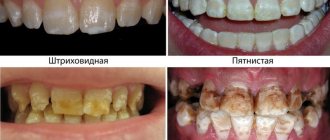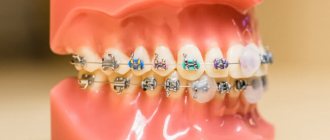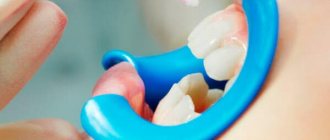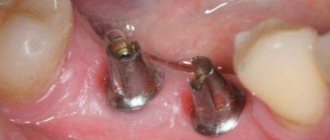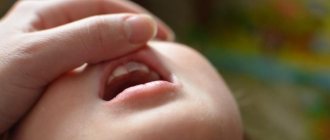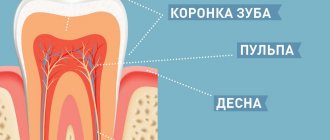What is Priestley's plaque?
Plaque on tooth enamel is nothing more than an uneven dark-colored border distributed along all the teeth. In rare cases, it appears as a small spot or dot. Plaque mainly forms on the inside of children's teeth, but there are cases of external formation.
Photos of black teeth in children
In this case, it is impossible to get rid of the black color of teeth by simply brushing them thoroughly with toothpaste. The fact is that the formation of dental plaque is associated with the presence of certain types of bacteria in the child’s mouth. As a result of their vital activity, deposits occur on the enamel, which cause pigmentation.
Not every child develops black plaque on their teeth. This is due to the fact that the body reacts differently to changes in food and the environment. For some people, the spot may develop gradually, but for some children they develop abruptly, literally overnight. And it doesn’t matter how old the child is: black plaque in children, as in the photo, can appear even when the first baby teeth erupt. But on average it is formed in 2 years.
It is not the formation itself that is dangerous, but the reason why it appears. After all, this is a signal not only about dental problems, but other diseases of the body. In this case, you should immediately consult a doctor.
Photos of Priestley's plaque in children can be seen below:
Treatment
Unfortunately, it is not always possible to return children’s blackened teeth to their natural milky shade.
- If the darkening of tooth enamel was caused by the accumulation of black plaque due to improper brushing techniques, then a visit to the pediatric dentist's office can solve this problem. The doctor will conduct an examination and professional cleaning of dense deposits on the teeth.
- Blackening of tooth enamel due to food coloring can be overcome even at home. To do this, you need to thoroughly brush your child’s teeth and rinse his mouth several times. After the first cleaning, the color of the enamel will become significantly lighter. If plaque stains black, then only professional cleaning in a doctor’s office will be effective.
- In case of caries, the main goal of treatment is to preserve the tooth, especially if the baby teeth have not yet changed and the child has not reached 6 years of age. With this disease, the black color of the cavity is caused by the accumulation of necrotic masses, food debris and colonies of bacteria, which are especially susceptible to staining with food pigments. After the doctor removes all the dead dental tissue and fills the cavity, the blackness will go away and the tooth will become light again. In exceptional cases, when it is not possible to cure caries, tooth extraction is performed.
- If the cause of tooth blackening is trauma, leading to rupture of pulp vessels and the formation of a hematoma, then during treatment the doctor will evaluate the possibilities of therapy based on signs of pulpitis (pain in the tooth area, high body temperature, complaints about deterioration of the general condition). If there are no signs of inflammation, then specific treatment is not required. But it is no longer possible to return the natural white color.
- Nowadays, dental problems caused by improper medication use are extremely rare in children. If such a problem occurs with milk teeth, then it will not be possible to solve it before the natural change of teeth. In this case, careful oral hygiene will be important so that the teeth do not turn blacker even more. If medications affect teeth from a permanent dentition, then in the future a professional whitening procedure will be required, and in extreme cases, prosthetics.
- As in the case of enamel damage caused by medications, it is not always possible to change the color of enamel in case of fluorosis of primary teeth. The main thing in treating such a pathology is to prevent its further progression by reducing the amount of fluoride consumed. It is especially important to do this in children under one year of age, since fluorosis affects not only the teeth, but also the child’s skeletal system.
- It is impossible to get rid of black plaque after silvering teeth. That is why this procedure is not recommended for school-age children, since it creates a cosmetic defect that can cause a negative reaction from others.
Causes of black plaque on children's teeth
Many parents have a question: why are children 2-4 years old susceptible to this disease? There are several reasons for this:
Carious deposits
- Dysbacteriosis can cause bacteria to multiply. It, in turn, is a consequence of disturbances in the functioning of the digestive system due to its immaturity. It may also be due to malnutrition of the baby or taking antibiotics, chronic liver or intestinal diseases.
- The cause of the appearance of black spots on the teeth is also considered to be caries, and, as a result, a black plaque forms on the child’s baby teeth.
- Most often, in a year or even two, parents do not take care of their baby’s teeth and do not clean them. This can cause a yellow coating to form, which becomes darker over time.
- Irregular brushing of teeth at any age of the child leads to the same result. Residues of food and dead mucous settle on the teeth, leading to darkening of the enamel.
- Another reason why a child has black plaque on his teeth is congenital hypoplasia of tooth enamel. The disease is associated with underdevelopment of the upper layer. As a result, it is weakened and does not fully perform its protective function, which is why black plaque appears on the child’s teeth.
- Black teeth in children can be the result of adverse effects at the stage of development of tooth buds. This may be an insufficient amount of calcium or an excess of iron in the diet of a pregnant woman.
Severe viral infections suffered during pregnancy also lead to the same consequences.
- When using medications and supplements containing iron, an excess of the substance can form in the child’s body, which also causes plaque to appear. In this case, it is not black, but dark brown or purple.
- Lack of calcium in children under one year of age leads to changes in the color of the enamel;
- A child may have black teeth due to a weak immune system. One of these reasons may be too dry indoor air. In this case, saliva production occurs in insufficient quantities. Prolonged illnesses also weaken the body, when the child has to take a lot of medications that adversely affect the functioning of the gastrointestinal tract.
- Black plaque can form on the teeth due to an incorrect bite or dental disease, in which you have to chew on one side. In this case, the unused side will be covered with plaque.
- Excessive consumption of sweets also leads to darkening of the enamel ;
- With diseases of the thyroid gland and diabetes, teeth often turn black;
- In rare cases, the reason for the appearance of formations is heredity. If one of the parents had such problems in childhood, there is a chance that the child will also develop the disease.
- Plaque can be the result of infection with worms and other parasites.
These deposits contain a large number of different bacteria, not only beneficial, but also aggressive. If you do not maintain oral hygiene and do not remove plaque on time, it will become denser and will adhere quite firmly to the enamel. These are favorable conditions for bacteria. And as they multiply, they lead to darkening of the top layer of teeth.
The appearance of plaque can spread to both the baby tooth and the permanent tooth.
For your baby, it is important to choose a toothpaste with the right composition. It should contain a minimal amount of fluoride or its complete absence . An excess of the element leads to the formation of black plaque on the teeth of children. For the most part, this applies to the incisors.
The photo shows a series of Splat toothpaste for children from 3 to 7 years old
Dr. Komarovsky on his official website answers in detail questions from parents about the appearance of black plaque in children. Video by Dr. Komarovsky about dental diseases in children:
A child’s baby tooth has darkened – why?
If you notice that your baby’s teeth have darkened or various spots have appeared, caries may have begun . You should immediately consult a doctor to identify the causes of their occurrence.
Darkened tooth
The most common is “bottle” or “creeping” caries - a common cause of darkening of the enamel in a child under one or two years old. When the baby falls asleep with a bottle of formula or porridge, and at night saliva is produced in insufficient quantities. Leftover sweet food is the optimal flora for the proliferation of microorganisms .
The reasons for darkening of the enamel can be different:
- lack of calcium in the body;
- early caries;
- slight production of saliva;
- use of iron supplements;
- mechanical injuries of the jaw.
Also, darkening of the enamel may be associated with enamel hypoplasia. This is a disease with non-carious lesions of teeth. The main signs include the appearance of gray or brown spots, specks, grooves, and dullness of the enamel.
The causes of hypoplasia are as follows:
- severe pregnancy of the mother (severe toxicosis, infectious diseases, malnutrition);
- fetal prematurity, birth trauma;
- Rh incompatibility, hemolytic disease in the fetus;
- frequent serious illnesses of the child in the first year of his life, poor nutrition.
If darkening of the teeth occurs against the background of incipient caries, the doctor may recommend silvering the enamel. The procedure involves applying a special solution with silver ions to the surface of the enamel. This method can be used from 3 years of age .
Fissure sealing is a method that eliminates carious lesions. The recesses in the tooth cavity are filled with a special solution, thereby preventing the penetration and proliferation of bacteria in the tissues. Fluoridation is the method chosen when there is a lack of fluoride.
And of course, you shouldn’t forget about daily dental hygiene, a balanced diet and regular visits to the dentist.
Diagnosis
The formation of black color on teeth can be a consequence of various diseases. In order not to waste time and not lead to complications, you should consult a doctor who will diagnose and prescribe treatment.
If a stain appears on a tooth, it is necessary to conduct laser diagnostics. It allows you to determine the stage and depth of caries. Based on the results of the examination, individual treatment is developed.
If other reasons have led to the formation of plaque, the doctor will prescribe additional tests. They will allow you to make a correct diagnosis and adjust treatment.
Use of medications
The appearance of black spots on the surface of teeth or darkening of the enamel in young children can occur due to the use of certain medications. Moreover, they can take them not themselves, but the mother during pregnancy.
Attention! Often, when a pregnant woman uses tetracycline antibiotics, it can lead to the formation of dark orange and brown plaque on the surface of the teeth in children. Also, this coloring effect can be achieved by preparations containing iron.
In these situations, the enamel cannot be lightened with treatment, so you will have to wait until the baby teeth are replaced with molars. Sometimes the use of medications by a woman during pregnancy can lead to the baby’s baby teeth erupting in black.
How to treat plaque
Regardless of the reason for the formation of black plaque in children, rough mechanical cleaning is not recommended . This will not only damage the enamel, but will also bring only a temporary effect - after a while, the black formations will return again. The exception is plaque caused by caries. In this case, you need to contact your dentist and start treating the tooth immediately, removing the formations.
.In most cases, the black spot persists until the baby teeth are replaced with permanent ones, which are less susceptible to plaque.
This does not pose any danger to health, so you just need to brush your teeth properly and take care of your oral cavity.
In other cases, the treatment process depends on the cause of plaque formation:
- If black spots appear due to problems with the intestinal microflora, it is necessary to reconsider the nutritional system. Special medications are also prescribed to establish the balance of microflora.
- If the balance of calcium and iron in the body is incorrect, an appropriate diet is prescribed. If necessary, treatment with medications is prescribed.
- If tooth decay began at an early age, a silver plating or fluoridation procedure can be performed. The process consists of treating tooth enamel with special means that seem to preserve the development of coating pathology. This procedure allows you to wait until your teeth change from baby teeth to permanent ones without serious consequences.
Various chronic diseases
Blackening of the enamel of baby teeth in a child aged 1 year can occur due to the presence of chronic diseases. Darkening of the enamel of baby teeth can be caused by the following diseases:
- various pathological processes of the digestive organs;
- liver diseases;
- diabetes;
- anemia;
- leukemia
In the presence of these pathological processes, dark spots, sometimes black, form on the surface of the enamel. But at the same time, the crown remains intact, it does not crack or collapse.
Important! Dark plaque on the surface of teeth can only be removed in a dental office. After complete removal of the dark plaque, the dentist coats the surface of the teeth with a special protective solution.
In order to prevent darkening of the enamel from occurring again in the future, it is necessary to carry out complex therapeutic therapy for chronic diseases.
Many chronic diseases can lead to blackening of teeth, this is due to taking a large amount of medication, which, like the disease itself, affects the microflora of the body.
A little about products that improve enamel color
You can’t get rid of Priestley’s plaque on your own, but you can improve the color of your enamel using the following products:
- Eating nuts and seeds can remove plaque and dark stains from your teeth. In addition, it is a source of a large amount of vitamins that help strengthen the body and, naturally, enhance its protective functions.
- Apples and pears contain a lot of water, which leads to the destruction of dangerous bacteria. They also help strengthen gums.
- Strawberries are a natural teeth whitener. It contains malic acid, which improves the color of the enamel.
- Broccoli will help maintain white teeth. The vegetable also removes dark deposits.
- Water without dyes is the best way to maintain a snow-white smile.
Reasons why baby teeth turn black
Poor nutrition and genetic predisposition are why a child’s baby teeth turn black. These are the two main factors identified by doctors. Poor nutrition involves not only the abuse of sweets, the reason may lie in vitamin deficiency, iron deficiency, when the child does not eat sweets, but there are not enough fruits and vegetables in his diet.
Or in excess fluoride, which most often enters the body with drinking water. All this can cause darkening of tooth enamel in preschool children.
Other reasons why baby teeth turn black may be:
- lack or poor absorption of calcium;
- diseases of the digestive tract;
- chronic diseases;
- metabolic disorders;
- insufficient oral hygiene;
- too thin, fragile enamel;
- taking medications.
Any of these reasons can cause changes in the composition and quantity of saliva, as well as in the microflora of the oral cavity. Food debris and bacteria always accumulate on tooth enamel in the form of plaque. In a healthy child, it is washed off and dissolved by saliva. If it is not enough due to, for example, chronic stomach disease, plaque is deposited, bacteria actively multiply - as a result, the tooth begins to darken and decay.
Whatever the root cause, plaque formation and darkening of the enamel are the first symptoms of caries. If a child’s teeth turn black, the process of destruction has already begun and it will proceed rapidly: children can lose a baby tooth in just a week. What to do in this case?
Complications of the disease
In addition to the aesthetically unattractive appearance, black formations can lead to other unpleasant complications:
- the appearance of an unpleasant odor from the oral cavity;
- formation of dental plaque;
- decay of tooth enamel due to carious processes;
- the formation of periodontitis due to damage to the gum mucosa due to ongoing inflammatory processes;
- the appearance of a sensitive reaction of teeth to temperature changes and taste sensations;
- bleeding gums;
- development of gingivitis and periodontitis;
- the appearance of inflammatory processes in the gum area.
Caries in children
Most often, individual teeth and entire groups darken as a result of caries.
It is considered as a polyetiological disease, and can be caused by excessive consumption of carbohydrates, hereditary predisposition, insufficient quality of teeth cleaning, etc. The direct cause of damage to enamel and dentin is bacteria. When a carious lesion is detected, all affected tissue is removed, and the resulting defect is “sealed” with modern filling material. Many parents believe that it is not necessary to treat baby teeth, since they will soon be replaced by permanent teeth, but this process will only be completed by the age of 12-14. Early removal of a carious baby tooth may subsequently cause malocclusion.
Important
It should be taken into account that the infection can affect the germ of a permanent tooth.
Primary teeth are more susceptible to caries than permanent teeth. Caries can develop in depth without a significant external defect; As a result, the teeth will turn black not from the outside, but from the inside, as it were, since the defect in the hard tissues will be visible.
Preventive measures
As you know, preventing a disease is easier than curing it. Therefore, it is necessary to take care of your teeth in advance and follow important prevention recommendations:
Silicone tip for cleaning the oral cavity of children
- As soon as the first tooth appears, parents should brush it with a special brush. It is put on the finger, after which the teeth are cleaned and the surface of the gums is simultaneously massaged.
- As early as one year, and if necessary, earlier, oral care should begin. Until the child learns to brush his teeth properly, he should be given assistance. The child must be able to use a brush correctly and know how to brush their teeth. The cleaning procedure should be carried out twice a day – morning and evening. The rest of the time after eating, you should thoroughly rinse your mouth with water or a special product.
Paste for adults should not be used when caring for a child’s oral cavity.
- After brushing your teeth in the evening, it is not recommended to eat food, especially sweets.
- A one-year-old child should regularly visit the dentist for preventative purposes. This will help identify the problem in time.
- During feeding, adults should not lick the spoon used to feed the baby. Thus, they can transmit bacteria that will cause the baby's enamel to darken.
- It is necessary to monitor the children's diet.
Food should be balanced and contain sufficient amounts of vitamins and minerals. Their intake should not lead to a deficiency or excess of minerals.
- You should not allow your child to drink coffee (you can make a weak drink with added milk) or strong tea (it is better to drink green or fruit).
- At the same time, the drinking regime must be correct. Your child should drink enough water, especially in hot weather, to avoid dry mouth.
- Maintain the correct balance of humidity and temperature in the room where the child spends most of his time.
- to introduce solid foods into the baby's diet . This leads to proper natural cleaning of the surface of the teeth. You can eat vegetables, fruits, crackers, crackers and hard cookies.
- To avoid drying out of the oral mucosa, it is necessary to ensure that the child breathes through the nose.
- To form a correct bite, you should wean your baby off the bottle and pacifier for up to a year .
Only by caring and attentive attitude of parents to the health of the child’s teeth can one avoid the formation of black plaque and maintain a snow-white smile.
Prevention
It is not difficult to prevent blackening of a child’s teeth. Parents should remember several rules that must be followed regularly:
- Be sure to monitor the quality of how your child brushes his teeth. It is necessary to start accustoming your baby to this procedure after the first tooth erupts, even if he has not reached one year of age. Correct formation of such a healthy habit in early childhood will help maintain not only the whiteness of your teeth, but also their overall health.
- Good nutrition plays a big role in preventing the blackening of baby teeth. The presence of the optimal amount of essential nutrients, as well as vitamins and minerals in the children's diet reduces the risk of developing dental pathology several times. In order for baby teeth to remain snow-white and not turn black, parents need to limit their child’s intake of sweets, carbonated sweet drinks, and white pastries. At the same time, solid raw fruits and vegetables and dairy products should be present in the diet every day.
- Correct selection of oral hygiene products. A child who is only 1 year old will not be suitable for toothpaste that is intended for school-age children. You need to change your toothbrushes regularly and choose them according to your age.
- In areas where the fluoride content in water exceeds normal levels, it is necessary to carefully monitor the quality of drinking water. This is especially true in children of the first year of life, when active formation of teeth and bones occurs.
- Regular visits to the dentist's office for preventive examination, treatment and professional cleaning can help you avoid teeth blackening in a timely manner.
- If it is necessary to treat shallow caries or prevent it, an alternative to silvering is the deep fluoridation procedure. It avoids the formation of unsightly black deposits and at the same time shows higher efficiency.
All doctors (including the famous Dr. Komarovsky) are unanimous in the opinion that preventing problems with children’s teeth is much easier than treating them. Regular adherence to preventive measures significantly reduces the risk that baby teeth will turn black or fall out before they are naturally replaced.
The child hit his front teeth and the tooth turned dark - What should I do?
Navigation:
- Symptoms of bruise
- Possible consequences
- Treatment
In childhood, tomboys often injure the oral cavity and dental system. Babies can fall when they learn to walk, because they do not yet know how to control their body.
Injury can occur when the toddler is actively exploring the environment, participating in sports, and also when participating in outdoor games. Most often the front incisor is affected. Every fourth child injures his frontal units while swimming.
A wet bathtub is slippery; when children fall, they hit the edge of the bathtub with their chewing organs. If a child hits his front teeth, parents should immediately react to this.
Remember! All dental injuries should be taken seriously. Some mothers and fathers think that if the baby incisor is damaged, then it’s not scary. It's a delusion! An injury not examined by a dentist in time can destroy the rudiments of permanent units. After all, the structure of temporary crowns is fragile, and their sharp edges can cause anomalies in the development of the root units.
When a child hits a tooth and it turns dark, the situation is not ordinary. Here you cannot do without a trip to the pediatrician and pediatric dentist. And the sooner this is done, the easier it is to help the baby. The complexity of the pathology will be assessed by the dentist. Hardware diagnostic methods may be required.
The organ can be dislocated, cracked, or broken. It can enter the gum. The unit may wobble from side to side and may scroll. The gum tissue turns red from inflammation, and the crown turns brown.
Taking into account all the circumstances, the dental surgeon will prescribe treatment or removal.
Symptoms of a tooth bruise
Immediately after an injury, an appointment with pediatric dentistry is required. Often parents bring their children after a week or a week and a half. This makes examination and treatment of lesions difficult. In the first hours after damage to the masticatory organ:
- Children feel pain.
- Pain increases when biting on a pathological unit.
- The gums swell, redden, and become dense.
- If, as a result of a bruise, a vascular bundle ruptures, blood appears, and pulpal hemorrhage may develop.
- The baby's condition worsens, he becomes restless and whiny.
- The temperature may rise. The child loses his appetite.
Only a doctor can help in such a situation. If a child’s baby tooth darkens after an impact, the blood vessels and pulp tissues could be damaged. In most cases, such processes are reversible. You should take your child to the doctor if there are signs of a bruise.
Without treatment, the structure of the abnormal units will suffer, which will negatively impact dental health. The symptoms of severe damage are easy to recognize. In addition to painful sensations, pinkish enamel is clearly visible due to rupture of blood vessels.
Brown spots appear after trauma to the periodontal tissues that hold the unit.
Possible consequences
Moms and dads must remember that the rudiments of the molars suffer from injuries to temporary rudiments. In such permanent teeth, enamel develops poorly and hypoplasia develops. The germ may even die. Therefore, treatment of baby teeth in children should be carried out on time.
If the pulp area is severely damaged, the tissues will gradually begin to die and become necrotic. Necrosis causes inflammation and discoloration of the crowns in a dark color. It happens quickly. After some time, cysts form on the damaged areas.
To establish a diagnosis, doctors refer for an X-ray examination.
If a child's baby tooth has been displaced by an impact, it may become loose for several weeks. Even slight staggering may occur due to damage to the alveolar process. When mammary rudiments are not treated after injury, it causes irreversible consequences.
Swelling and redness usually appear in the area where the main impact occurred. The hematoma can be pronounced, and can also be determined only during palpation. When you press it, the baby experiences discomfort and pain. A fracture of the alveolar process is expressed by pain when moving the jaws.
If the ligaments are torn, pain is observed on the entire surface of the dental system.
Treatment recommendations
Many dentists recommend monitoring oral hygiene from childhood. But even careful and regular hygiene cannot protect a child from premature blackening or decay of teeth. Therefore, if you suddenly notice darkening of your child’s teeth, it is best to immediately consult a dentist. At the appointment, the doctor will conduct an examination, identify the cause of the darkening of the enamel and provide the necessary treatment. If necessary, he can refer to other specialists to eliminate other concomitant diseases. But most importantly, the doctor will be able to provide effective treatment measures:
- At the initial stage, to eliminate blackening, the doctor can undertake effective therapy - silvering. During this treatment, the surface of the teeth is coated with a special composition containing silver. But this method is only allowed for children over three years old;
- There is another effective method that eliminates carious lesions - fissure sealing. Folds or recesses are filled with special compounds. As a result, all pathogenic and pathogenic bacteria stop spreading and actively multiplying. This procedure is recommended to be carried out within a year after teething;
- If the disease is caused by a lack of fluoride, then fluoridation of teeth is performed.
Fissure sealing is a method of preventing caries of chewing teeth. Fissures are natural depressions on the chewing surface of teeth in which food particles accumulate, which leads to the development of caries.
Danger and possible complications
Plaque on a baby’s teeth is not harmless. It affects the child’s well-being and the functioning of his internal organs:
- makes gums hypersensitive,
- creates bad breath,
- promotes inflammatory processes in the oral mucosa,
- causes gums to bleed not only during brushing, but also when chewing food,
- periodontitis appears
- gingivitis develops.
If the pathology is not treated in a timely manner, the situation can reach such a state that it will be very difficult to help correct the problem. In addition, delayed treatment can lead to complications, the variations of which depend on the characteristics of the child’s body.
Metabolic disorder
Blackening of teeth and the appearance of stains on the enamel in children can occur due to metabolic disorders. A metabolic disorder in a child’s body can occur due to an unbalanced diet, as well as due to poor absorption of calcium. So what does metabolic disorder in children lead to:
- First of all, a change in the composition of saliva in the oral cavity occurs;
- the alkaline composition in the oral cavity is disrupted;
- A dense plaque accumulates on the surface of the enamel, which after some time turns dark.
Metabolic disorders and deterioration in the quality of teeth can occur due to frequent consumption of sweet foods, as well as due to non-compliance with the necessary hygienic oral care. If a child has dental problems due to metabolic disorders, you should immediately contact a pediatric dentist. At the appointment, the doctor will conduct an examination and provide the necessary treatment.
A disorder of the digestive system can lead to increased acidity, which will negatively affect the condition of the teeth and can lead to decay and darkening of the teeth.
How mothers deal with darkening of teeth
Many mothers are faced with dark milk teeth in their children. On the forums, more experienced people write that over time, the darkening of the enamel often goes away, or the baby teeth remain dark, but the molars erupt normally.
Often, if the teeth darken, this can be a sign of caries, so parents often simply silver their teeth preventatively to keep the teeth healthy.
And some even bring their child for professional cleaning, and this sometimes helps not only to remove darkening of the teeth, but also to get rid of caries. In any case, taking your child to the doctor is a great idea.
Bottle caries
The most common problem of darkening the enamel of baby teeth is bottle caries.
However, many parents are in no hurry to see a dentist. This is due to the fact that many people believe that baby teeth will fall out on their own anyway, so they do not need to be treated. But it is worth considering that premature destruction and loss of teeth can lead to improper formation of the jaw.
Bottle caries is also called “milk” and “nursery”, less often – “nipple” or “night-feeding caries”. Dark yellow spots and abrasions appear on the child’s teeth, which can be all over the surface of the teeth.
During the examination, the pediatric dentist may suggest several treatment options. But the filling option is not suitable for children, because the traditional method of treatment is quite complex. Treatment of carious lesions using the silvering method is usually used. This method consists of treating the crown with a solution that contains silver. This solution significantly reduces the process of tooth decay.
During fluorosis, the front teeth darken and stains form on the enamel. This process occurs due to the increased fluoride content. It is also worth paying attention to several main features of this process:
- At the initial stage, white spots and stripes form on the crown;
- After some time, an increase in the size of spots and stripes is observed. These formations become yellow with a brown tint;
- In the subsequent period, gradual abrasion of the enamel and deformation of the dentition occurs.
Fluorosis is a dental condition that often appears as mottled enamel. It occurs with prolonged intake of fluoride in the body in large doses.
